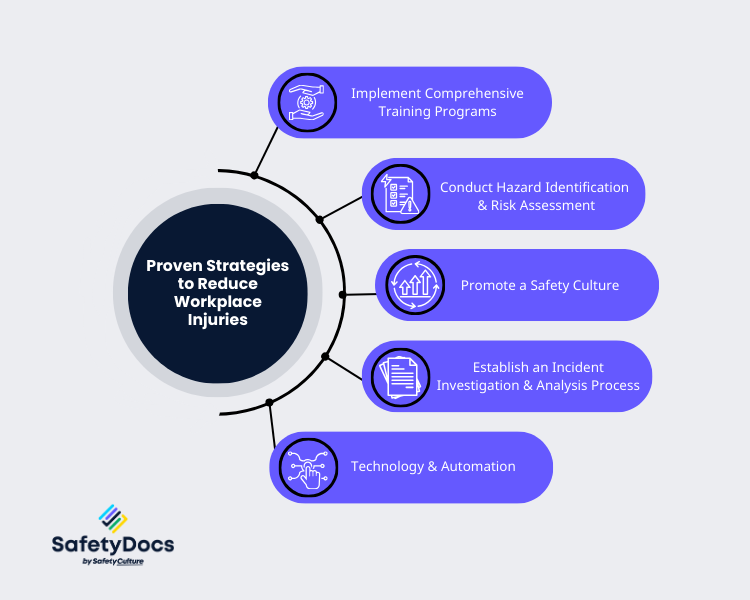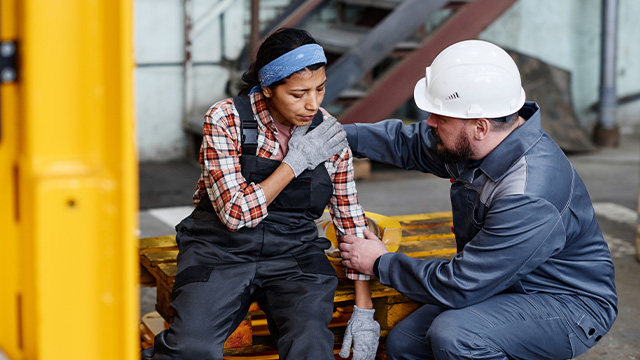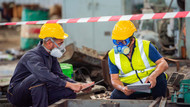In 2022, there were 195 tragic worker fatalities resulting from injuries sustained during work-related activities. Injuries in the workplace are serious issues that can have devastating consequences for both employees and businesses. Despite implementing top-notch safety protocols, accidents can still occur. So, What can companies do to ensure a safer work environment?
In this article, we delve into the strategies that have proven effective in reducing and preventing workplace accidents and injuries and creating a safer working environment.

Proven Strategies to Reduce Workplace Injuries
1. Implement Comprehensive Training Programs
Training is the foundation of a safe workplace. It equips employees with the necessary knowledge and skills to identify hazards, prevent incidents, and respond to emergencies. Regularly updating training programs ensures that employees are up-to-date with industry standards and best practices.
Investing in thorough training programs ensures that employees are well-prepared for the challenges of their roles. Here are examples of training programs that can contribute to reducing and preventing workplace injuries:
- Health and Safety Inductions for New Hires: Ensures new employees are familiar with safety protocols, procedures, and emergency response plans.
- Job-specific Training: Provides job-specific safety guidelines and instructions on how to use personal protective equipment safely.
- Refresher Courses: Regularly reinforce essential safety practices through refresher courses. This could include manual handling, fire safety, and emergency evacuation.
2. Conduct Hazard Identification and Risk Assessment
Hazard identification and risk assessment are vital in proactively addressing potential workplace incidents. Hazard identification is about finding potential dangers, while risk assessment involves evaluating and ranking these hazards according to how likely they are to happen and how serious they could be.
How often should these hazard identification and assessments be conducted? Who needs it the most? Here is a guide to help you make informed decisions:
- Frequency: Regularly perform hazard identification and risk assessment, ideally at least once annually. Should there be any changes in the work environment or processes, it's advisable to carry out this assessment promptly to ensure ongoing safety
- Employee Participation: Encourage employees to identify potential hazards and report them. After all, they are on the ground and may notice things others overlook. Their participation will lead to a safer working environment for all.
- Industry: The risk levels vary by industry. Those with higher-risk activities should conduct these assessments more frequently. For example, manufacturing companies may need to conduct them more often than office-based businesses.
In Australia, conducting risk assessments in the workplace is mandatory under the Work Health and Safety (WHS) Regulations for high-risk activities such as working in confined spaces and live electrical work
3. Promote a Safety Culture
A strong safety culture is one where safety is at the top of everyone's minds. A company that values and prioritises employee safety creates an environment where employees feel safe, appreciated, and motivated to work. Here are some ways to promote a safety culture in your organisation:
- Open Communication: Encourage open communication between employees, management, and safety officers. This allows for the easy reporting of safety hazards and incidents.
- Recognition of Safe Practices: Recognising employees who practise safe behaviours creates positive reinforcement. This motivates other employees to do the same, creating a ripple effect that promotes organisational safety.
- Safety Training for Management: Managers and supervisors are crucial in promoting safety within their teams. Providing them with training on identifying, monitoring, and addressing workplace hazards can significantly contribute to creating a safety culture.
4. Establish an Incident Investigation and Analysis Process
Investigating and analysing incidents is crucial in understanding their root causes. This knowledge can then be used to prevent similar events from occurring in the future. When an incident occurs, the workplace should immediately undergo a thorough investigation.
The analysis process should aim to answer the following questions:
- What caused the incident?
- Were there any gaps in our safety protocols that contributed to it?
- How can we prevent similar safety incidents from happening in the future?
A thorough investigation process should involve:
- Prompt Reporting: Incidents should be reported as soon as they happen to ensure timely investigations.
- Root Cause Analysis: Identify the cause of the incident, not just what happened.
- Corrective Actions: Based on the root cause analysis, implement measures to prevent similar incidents, such as implementing additional safety training, revising protocols, or providing new equipment.
5. Adopt Technology and Automation
Technological advances have enabled the automation of many tasks that were once physically demanding or potentially hazardous. These advancements have significantly reduced the risk of workplace injuries. Adopting technology can also improve employee productivity and efficiency.
Here are some ways businesses can use technology to reduce workplace injuries:
- Wearable Technology for Monitoring Employee Health: Wearable technology, such as smartwatches and fitness trackers, offers real-time employee health monitoring, providing insights into potential issues before they escalate.
- AI-Powered Safety Systems: Artificial intelligence can analyse vast data to identify patterns and potential risks.
- Virtual Reality Training: Virtual reality training simulates workplace scenarios, allowing employees to practise safety procedures in a controlled environment. This innovative approach improves preparedness and reduces workplace accidents.
- Explore Technology Solutions like SafetyCulture: Enhance workplace safety with platforms like SafetyCulture, which offers technological tools for inspections and incident reporting. Its features, like customisable checklists and analytics help identify risks efficiently, complementing other tech advancements like wearable monitoring devices, AI-powered safety systems, and virtual reality training for a comprehensive approach to reducing workplace injuries.

Understanding Common Workplace Injuries
There needs to be more than preventive measures in place. Organisations must also understand the most common workplace injuries to take targeted action towards reducing them.
Types of Injuries
Slips, Trips, and Falls
The Australian Institute of Health and Welfare reports that slipping, tripping, or stumbling on the same level is a leading cause of hospitalisation due to falls, with over 73,000 hospitalisations recorded in 2021–22. Accidents resulting from slips, trips, and falls rank high in terms of frequency when it comes to workplace injuries.These workplace accidents can lead to severe damage caused by wet floors, uneven surfaces, or cluttered walkways. Understanding the root causes is crucial for effective accident prevention plans.
Musculoskeletal Injuries
The most common industries in Australia where musculoskeletal injuries occur include Contract Cleaning, Health Care, Aged Care, Manufacturing, Transport and Logistics, Warehousing, and Construction. These injuries are often caused by repetitive movements such as typing, lifting heavy objects, or sitting for extended periods. MSDs can lead to long-term health issues, affecting an employee's productivity and quality of life.
Repetitive Strain Injuries (RSIs)
Repetitive Strain Injuries (RSI) are similar to MSDs but are caused by prolonged, repetitive movements, such as typing or using a mouse. These injuries can lead to musculoskeletal disorders, nerve damage, and carpal tunnel syndrome.
Machinery Accidents
Working with machinery poses a significant risk of severe injuries, such as amputations, crush injuries, and lacerations. Those working in construction, manufacturing, and agriculture are most at risk. Operating machinery without proper training, emergency equipment, or protective gear can significantly increase the likelihood of accidents.
Contact with Hazardous Materials
Industries that work with hazardous materials, such as chemicals and biological agents, are at risk of exposure. This can lead to skin irritations, respiratory issues, and long-term health problems. Employers must provide proper training and safety protocols for handling these materials to prevent related injuries.

Workplace Safety Laws in Australia
In Australia, workplace safety is governed by Work Health and Safety (WHS) laws, legislated and regulated separately by each state, territory, and the Commonwealth. The links to Safe Work Australia featured here are crucial for understanding the model laws that form the foundation of workplace safety regulations across Australia. These model laws provide a comprehensive outline and serve as a reference point for state-specific legislation.
It's important to note that Victoria, while participating in the broader framework, maintains its own distinct workplace safety regulations.
Work Health and Safety Act 2011 (WHS Act) provides a framework to protect all workers' health, safety, and welfare at work. It also protects the health and safety of all other people affected by the work. The WHS Act covers physical security as well as psychological health.
- Work Health and Safety Regulations 2011 (WHS Regulations): These regulations are made under the WHS Act and provide detailed requirements to prevent or minimise a worker's exposure to risk. They cover a range of workplace activities that pose risks to workers' health and safety, including working with hazardous chemicals and operating heavy machinery.
- Codes of Practice: These are practical guides to achieving the health, safety, and welfare standards required under the WHS Act and the WHS Regulations. If an employer follows a Code of Practice, they will be deemed to comply with the health and safety duties in the WHS Act and the WHS Regulations to the extent it applies to their situation.
- Australian Standards: These are published documents outlining specifications and procedures to ensure the safety, reliability, and consistent performance of products, services, and systems across various industries. Subjects covered include consumer products, construction, engineering, and information technology.
Implement these Strategies with SafetyDocs
Let us help you achieve a safer workplace. SafetyDocs by SafetyCulture offers customisable and up-to-date safety documents that can assist any industry in preventing injuries in the workplace. We are Australia's most trusted occupational safety management systems provider, providing accessible and easy-to-use OHS/WHS templates.
Our library includes templates for risk assessments, job safety analyses, standard operating procedures, incident reports, and more. With SafetyDocs, you can:
- Easily create accessible safety documents for your employees
- Avoid missing important safety information or requirements
- Save time and resources by using ready-made templates tailored to your industry's needs
- Stay compliant with Australian workplace laws and regulations
- Improve your overall safety culture by prioritising workplace safety
Don't wait until a workplace accident happens. Start implementing these strategies today with SafetyDocs. Contact us for more information or to get started.
Our team of experts is dedicated to providing accurate and informative content. Craig Cruickshank, our senior HSEQ advisor at SafetyDocs by SafetyCulture has reviewed this blog post to ensure the highest level of quality.
Learn more about Craig's work on LinkedIn for more industry insights.
Available for instant download and supplied in fully editable MS Word format for use in your business.
Please note that the above information is provided as a comment only and should not be relied on as professional, legal or financial advice.
Share This Article
